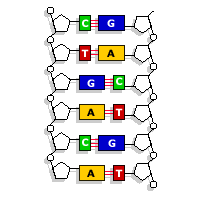By Ivan Noble
BBC News Online science staffScientists in the US have published the results of their detailed scrutiny of the genetic sequence of the human Y chromosome.
This DNA bundle - one of 24 distinct chromosomes found in human cells - holds the crucial information to make the male of our species.
The work is part of the enormous job of following up the data that came out of the international Human Genome Project (HGP).
The results provide important insights into how humans evolved and may explain how some kinds of infertility occur.
The HGP revealed the 2.85 billion letters of genetic code that instruct our cells how to build and maintain the human body.
The work of refining this DNA sequence to higher levels of accuracy was declared complete in April.
Any attempt to make sense of the data inevitably involves large-scale computing effort, but, by any standards, annotating the Y chromosome was a huge task.
"It's one thing to generate the sequence and its another to go on to discover which bits are functional and what they can tell us about disease and evolution," explained Mark Ross, head of the Wellcome Trust Sanger Institute's project to analyse the X chromosome near Cambridge, UK.
The Y chromosome contains a great many repeated sections of DNA and far fewer genes, letter for letter, than other chromosomes.
Francis Collins, director of the US National Human Genome Research Institute, said in Washington DC on Wednesday that the Y was the fifth chromosome of the completed human genome sequence to undergo detailed analysis.
"The Y was the most challenging - the most difficult chromosome," he said.
The scientists found 78 genes in total on the Y, many but by no means all of them to do with sperm production.
One is the sex determining gene, the "master switch" that makes a baby boy; another is a gene that has some sort of function in the brain and is not found on the female X chromosome.
For every million letters of genetic code they looked through, the researchers found only three genes, far fewer than the 10 per million average throughout the rest of the genome.
The chromosomes in the nuclei of our cells are arranged in pairs (females have two copies of the much larger X, while men have an X and a Y).
Researchers say the chromosomes draw on their mate to carry out repairs to genes that suffer mutations through disease or replication errors.
But the Y cannot do this with the X, and it therefore carries backup copies of important genes within itself. It will use one copy to fix a flaw in another - a process called gene conversion.
Dr David Page, from the Whitehead Institute in Massachusetts, who led the team deciphering the Y chromosome, said: "The sex chromosomes represent a grand experiment of nature.
"In our work, every few years we've caught a glimpse of some unexpected aspect of this experiment. And of all these aspects, this Y-Y gene conversion is one of the wildest."
Dr Page said it was probably when this gene-fixing technique went wrong that some male infertility problems arose.
He said doctors were already using his team's data to understand the genetic origins of male infertility.
He added that genes on the Y might play a role in influencing gender-specific differences in disease susceptibility.
The Y chromosome work is reported in the journal Nature.
THE HUMAN GENOME 
The double-stranded DNA molecule is held together by chemical components called bases
Adenine (A) bonds with thymine (T);
cytosine(C) bonds with guanine (G)
These letters form the "code of life"; there are about 2.9 billion base pairs in the human genome wound into 24 distinct bundles, or chromosomes
Written in the DNA are less than 30,000 genes which human cells use as templates to make proteins; these sophisticated molecules build and maintain our bodies


 Home
Home

 Help
Help

 Search
Search

 Login
Login



 Home
Home

 Help
Help

 Search
Search

 Login
Login
